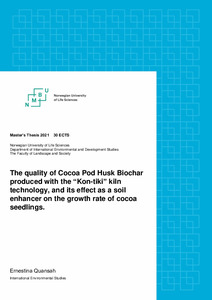| dc.contributor.author | Quansah, E. |
| dc.date.accessioned | 2022-11-30T08:36:25Z |
| dc.date.available | 2022-11-30T08:36:25Z |
| dc.date.issued | 2021 |
| dc.identifier.citation | Quansah, E. (2021). The quality of Cocoa Pod Husk Biochar produced with the "Kon-tiki" kiln technology, and its effect as a soil enhancer on the growth rate of cocoa seedlings. Norwegian University of Life Sciences, (76p.) |
| dc.identifier.uri | https://hdl.handle.net/20.500.12478/7939 |
| dc.description.abstract | A study was conducted to investigate the potential of cocoa pod husk as feedstock for biochar production using the “Kon-tiki” kiln. The effect of cocoa pod husk biochar (CPHB) as a soil enhancer, was tested in particular with respect to the soil’s capacity to retain moisture and nutrients, and their consequences for the growth rate of cocoa seedling on two soil types. The resultant CPHB biochar was applied on two soil types from Ghana, Acherensua (sandy loam and near neutral) soil and Ayinase (clayey loam and acidic) soil at rates of 0%, 5% and 10% (wt./wt.). Cocoa seedlings were grown in polybags in a greenhouse at the Cocoa Research Institute of Ghana (CRIG), adding 100ml of water per pot, at 5 days’ intervals for four months. Soil moisture, soil nutrients and growth parameters were monitored for four months. Soil moisture content and chlorophyll levels of the cocoa leaves were measured weekly 5 days after watering, with time domain reflectometry (TDR) and chlorophyll meter respectively. Data on soil nutrient content were collected after the seedlings were harvested. Plant growth parameters (i.e. stem height, stem diameter, stem dry weight, leaf area, leaf dry weight, root length, root volume, root dry weight, and total dry weight) were determined in the second and fourth month. Using the Kon-tiki kiln, I found that 245.5kg of CPH biomass produced 82.5kg of biochar (CPHB), indicating a 33.4% biochar yield. The cocoa pod husk biochar was alkaline (pH=10.8), total nitrogen (1.06%) and available phosphorus (277μg/kg) were high. This supports earlier results for CPHB using different techniques. The addition of biochar to the soils caused a significant increase in both soil moisture content (p<.0001) and soil nutrient content (N, P and K) (p<0.05). The 5% CPHB treatment significantly increased almost all growth parameters (except root dry weight, root volume and stem dry weight) at the end of the experiment. However, the growth response to biochar addition was highly non-linear, with 10% CPHB treatments resulting in significant declines (p<0.05) in stem height, stem dry weight, leaf dry weight, leaf area index, root volume, root dry weight, and total dry weight relative to the control. The study recommends 5% CPHB application to enhance soil quality and seedling growth. Not only were these positive effects of 5% CPHB seen in the acidic soil, but also in the near neutral soil. The study estimated that about 956.3-1277.5kg CPHB can be produced per ha using the “Kon-tiki” kiln technology. |
| dc.format.extent | 76 p. |
| dc.language.iso | en |
| dc.publisher | Norwagien University of Life Sciences |
| dc.subject | Cocoa |
| dc.subject | Seedlings |
| dc.subject | Soil Moisture |
| dc.subject | Plants |
| dc.subject | Nutrients |
| dc.subject | Growth Rate |
| dc.title | The quality of Cocoa Pod Husk Biochar produced with the "Kon-tiki" kiln technology, and its effect as a soil enhancer on the growth rate of cocoa seedlings |
| dc.type | Thesis |
| cg.contributor.affiliation | Norwegian University of Life Sciences |
| cg.contributor.affiliation | International Institute of Tropical Agriculture |
| cg.coverage.region | Africa |
| cg.coverage.region | West Africa |
| cg.coverage.country | Ghana |
| cg.coverage.hub | Headquarters and Western Africa Hub |
| cg.identifier.bibtexciteid | QUANSAH:2021 |
| cg.authorship.types | CGIAR and advanced research institute |
| cg.iitasubject | Agronomy |
| cg.iitasubject | Biodiversity |
| cg.iitasubject | Cocoa |
| cg.iitasubject | Crop Husbandry |
| cg.iitasubject | Crop Systems |
| cg.iitasubject | Genetic Improvement |
| cg.iitasubject | Plant Breeding |
| cg.iitasubject | Plant Ecology |
| cg.iitasubject | Plant Production |
| cg.iitasubject | Soil Fertility |
| cg.iitasubject | Value Chains |
| cg.notes | IITA supervisor: Dr. Asare R. |
| cg.publicationplace | Norway |
| cg.accessibilitystatus | Limited Access |
| cg.reviewstatus | Internal Review |
| cg.usagerightslicense | Copyrighted; all rights reserved |
| cg.targetaudience | Scientists |
| cg.futureupdate.required | No |
| cg.contributor.acknowledgements | I am very thankful to the Department of International Environment and development studies and to the university (NMBU) for allowing me to undertake this thesis work to mark the end of my studies. Additionally, I am thankful to the Cocoasoils programme and IITA for giving me the opportunity to work on this project and for their support throughout this project.
I would like to express my sincere gratitude to my supervisor, Professor Jan Mulder and Ola Westengen, for their time, valuable guidance and constructive feedbacks that inspired and motivated me to complete this dissertation. Also, I would like to express my gratitude to my field supervisor, Dr. Amos Quaye, for his invaluable guidance throughout my fieldwork. I am most grateful to Dr. Richard Asare for the opportunity to join as a research student in the Cocoasoils programme.
I am most grateful to my friends, who read through my dissertation and the final thesis paper and offer invaluable suggestions and criticisms. |

